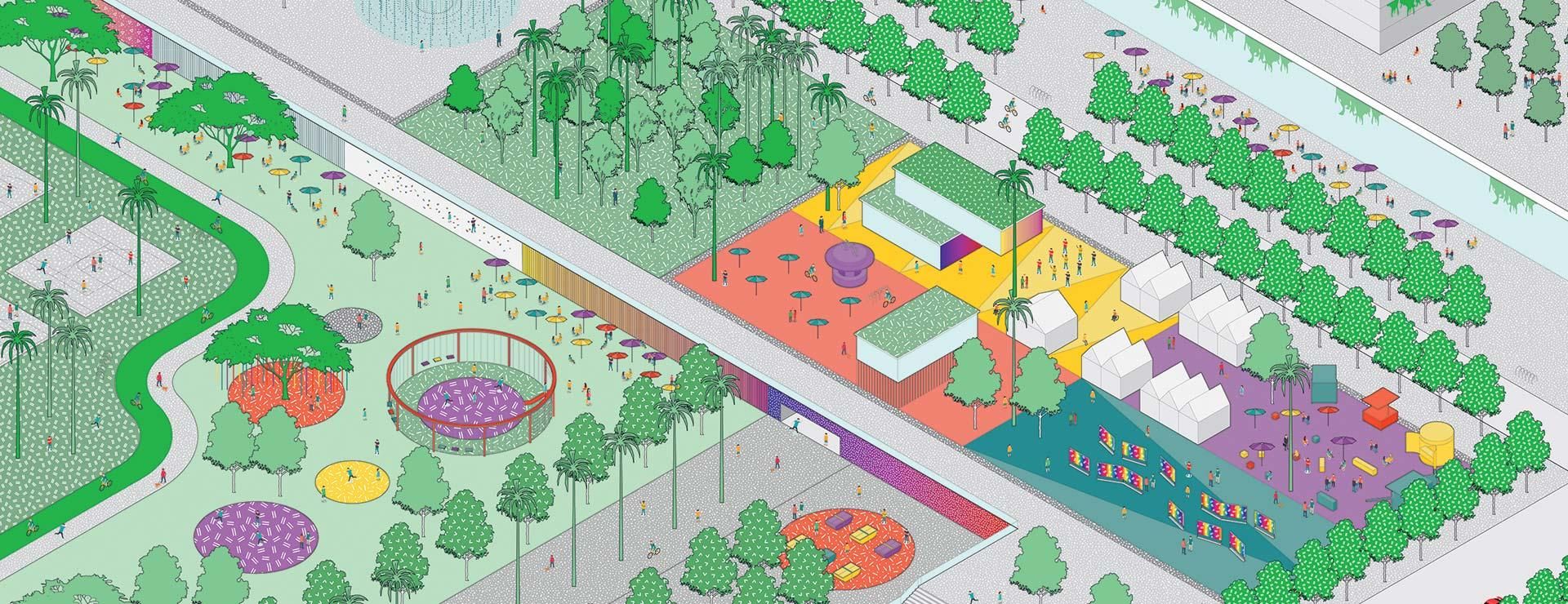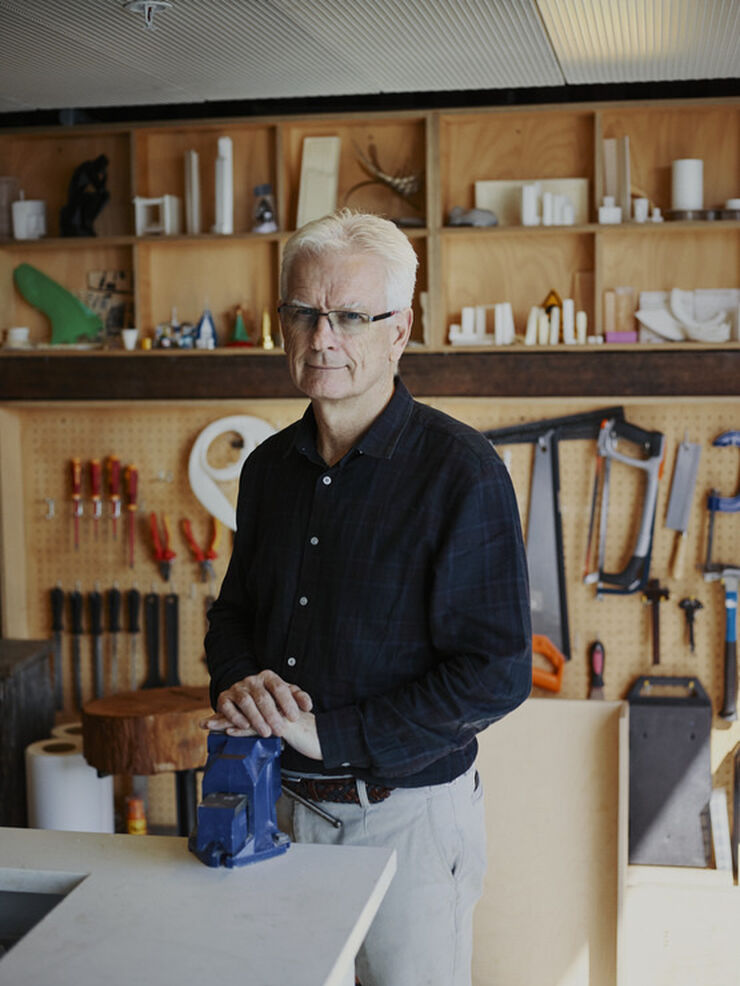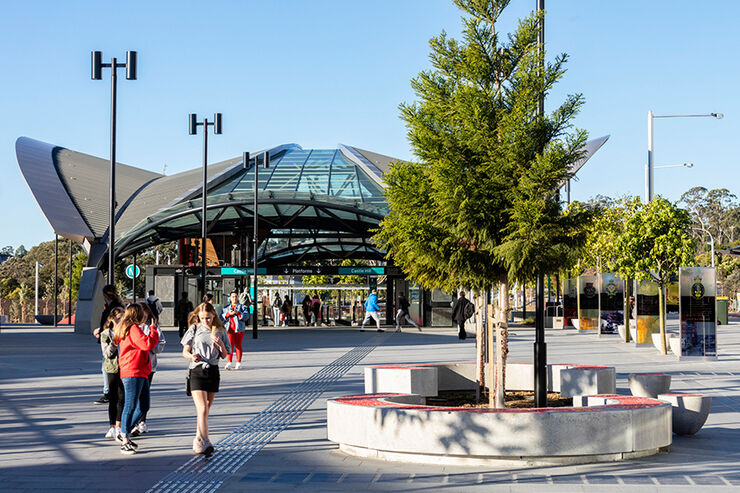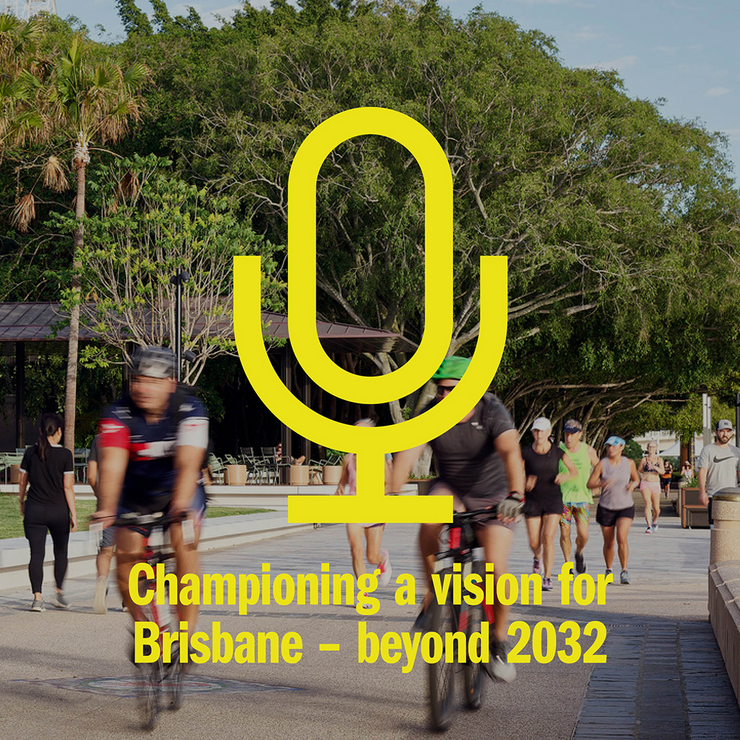Transcript
Ross de la Motte begins introducing the episode:
Hello, I’m Ross de la Motte. I’m a principal of Hassell. I’m passionate about the city and the way we live and get around our cities.
We’re very fortunate to be here, here in Sydney, in the Hassell studio, in a city that’s undergoing extraordinary transformation. I really don’t think we are going to see anything like this, probably for three or four generations, because the city at the moment is a bit like a war zone at times, with enormous demolition and construction happening. This investment in the city, the CBD, is now about to go west. It’s made me think of the last time we went through such a phenomenal transformation. It was almost two decades ago for a few lovely weeks in September, where we rediscovered ourselves.
Archived news audio - Juan Antonio Samaranch:
The winner is Sydney.
Archive news audio - news reader:
Sydney as the city to host the Olympics for the year 2000.
Archive news audio:
I declare open the games of Sydney.
Archive sports commentator:
… the crowd roaring, [inaudible 00:01:04]. Cathy is the winner, Australia, the winner.
Ross de la Motte continues his narration:
We became civil and communal. We were really proud of what we had achieved with the amazing infrastructure and buildings that we’d built. We did this amazing thing where we volunteered on a massive scale because we wanted to get invested individually and make a difference.
Archive news audio - vox pop with public:
It was just such a good feeling to be able to do something for Australia.
Ross de la Motte continues his narration:
At the end of it all, we reclaimed a wasteland. We built a whole new regional centre. We built a model village in a park, and it was all founded on a new model of mobility. We imagined what we could do and what we could be. And I think we became better people.
Archived news audio - Juan Antonio Samaranch:
[inaudible 00:01:49] to the world the best Olympic Games ever.
Ross de la Motte continues his narration:
So where are we today? Our streets are tense. We are tense in our streets. A lot of us are transfixed by our mobile phones, and we look down more than we look up. The very simple humanity of acknowledging somebody sitting next to you on a bus or on a seat or on a train has gone. I think that’s a tragedy of a micro scale, but it’s repeated millions of times every day.
I’m joined here by Ralph Ashton, the director of the Australian Futures Project, and we’re going to have a conversation about our city. Will it continue to be a suburban city? Or could we perhaps create something which is super urban, whatever that might be?
Ralph, maybe could you give us some background on the Australian Futures Project? How does it work, and what are your core activities?
Ralph Ashton speaks
We work in four ways. We gather data and insights on what Australians want for the future and what the big challenges are. We use that research then to change the conversation from short-term problems to longterm solutions. We create solutions to the most broken parts of the system, so we have a leadership programme for parliamentarians, is one example of trying to fix a part of the system that politicians themselves have identified as broken. Then finally, we support other organisations who are trying to improve the future-making systems. We bring our expertise in systems thinking in from the data and insights and also entrepreneurialism to make things possible.
Ross de la Motte asks:
I want to bring you back to urbanism, community and the future of our cities. That really seems to me to be the point at which we are breaking down.
Ralph Ashton answers
Another view on this is that we’re also living in one of the best times ever. So on lots and lots of measures we, in Australia, and even globally are experiencing a great flourishing and a great thriving.
But I agree with your diagnosis and what you’ve pointed to. At the heart of this, I think there has been a failure of imagination and a failure to choose, and we’ve slept-walked into this new reality. Whereas we could have, like we did for the Olympics in 2000, we could be at every moment making choices, which say we want a future, even a future in the next couple of years, let alone the next 30, 50, 100. We want a future that looks like this, and we’re going to do the things that are required to get to that future, including the trade-offs that are necessary to get there.
But we haven’t done that. Instead, we’ve just sort of stumbled from one thing to the next to the next and we’ve created something, which I don’t think is as good as we could have and is even what we, as Australians or Sydneysiders, want for our city, for our country.
Going back to the preparation for the Sydney Olympics, what was it about politics, about the bureaucracy, about regulators, about designers, about developers, what was going on that made that possible? Because that didn’t happen overnight.
Ross de la Motte asks:
On so many layers it was we wanted to be on the world stage. We wanted to say to the world that Sydney could do this better than anybody, so it was motivated by pride. And we won, perhaps against the odds, and everybody thought, “Holy hell. Now the pressure’s on.” So at all levels of society, everybody thought this is wonderful. Government, financiers, designers, builders, everybody mobilised with a singular idea. We were going to create something, which was wonderful, of a world’s quality and deliver it on time. And we did.
But the wonderful thing was that it was dealing with an inherent problem. We had 450 hectares of wasteland. So that layered in another thing, which was an environmental responsibility. People could see that by rehabilitating a wasteland, we could create something wonderful and good out of basically a disaster.
What people like me, architects, landscape architects, engineers, governments, what we are doing is we are providing for the physiological, we’re providing for the safety and security issues. But this ability of a community and the professions and government to imagine and build a sense of community, a sense of belonging where you enjoy and know your neighbours, I think that’s really where we’re failing. And until we get that sorted, we’re not going to create beautiful cities that have a lovely, enjoyable lifestyle.
Ralph Ashton answers
Compared to other countries, we’re probably doing really well, and compared to other countries, we’re doing not so well. I think we’ve done really well on safety for the most part around crime and law and order.
Then when we get to community, I think this is a really, really important point, and it comes back to what we were talking about at the start, which is we’ve got all the money and all the imagination and the skills and capability to decide we want to create cities like this. We want Sydney to be like this. That we can get around, that we can have a sense of community that is not just cookie-cutter subdivision, and that it’s serving more purposes than just housing and the economy. Everything you’ve talked about, urban planning, design, building, architecture, infrastructure, planning, they’re so central to creating this sense of community. And we’ve lost that.
Ross de la Motte comments:
Perhaps because we’re just doing it on such a gargantuan scale, it’s all happening so fast it’s almost beyond control. I wonder whether part of our problem is in having not really imagined and done work for 20 or 30 years in true city planning, which is truly integrated. The backlog of work is so great now that we’re initiating and procuring projects that are so big, that it is all about just getting it built.
Is it about leadership? It’s not only the leadership of government, but it’s our approach to leadership that we can all can make a difference.
Ralph Ashton answers
Definitely we can all make a difference. And, of course, some of us in better positions to make more of a difference or make a difference at a different scale than others.
We think of it as a good future making systems. So a system that will help us create a future that we’re proud of and happy to live in and is balanced amongst lots of different competing desires, but that it really needs to have in society, we need four things.
The first is the understanding of the vision and the identity. Who are we and what do we want to become? That’s about aspirations. What do we want to become in the next three, five, 10, 50 years? I’m talking we, as in, we citizens. It’s about our concerns. What are we most concerned about? What do we want fixed? What are the things that are annoying us right now? And it’s about our values. I think the values bit gets dropped off quite often. That’s very much about how we want to approach our concerns and our aspirations. Do we want to be generous or greedy? Do we want to exclude people or include people? Do we want to go fast or slow in solving these things? Do we want to try and find solutions that meet multiple needs? Or are we happy just to go quickly for a trade-off? That’s all about vision and identity.
Then the other three things are a nationhood, the sense that we as individuals, but not just as individuals, we as individuals and entities, so institutions like government, political parties, organisations like businesses, big business, small business, that we see that there’s a benefit in us being part of something bigger, whether it’s a suburb or a city or a country, and that we are willing, every now and again, to put our own sort of needs and desires down a peg or two so that we can get something good for the whole.
Then the third is reality that we’ve listened to what the experts are telling us. That we can’t just have everything pie in the sky, that we can’t just always have what we want. Or we might also be blind to some really big opportunities and challenges. And if we don’t listen to the experts about what the reality is, we’re building our house on sand, rather than stone.
Then very quickly the fourth sort of fundamental for this good feature-making system is leadership. It’s the action and the leadership that is consistent with the vision and identity of the people and that reality. Often it means explaining to people that either there’s this big challenge we need to deal with, whether it’s town planning or climate change, and that sometimes we can’t have everything we want all at once.
Ross de la Motte comments:
How can Australia, how can communities, how can individuals recapture that essential idea of trust in each other?
Ralph Ashton answers
Well, I guess I could ask you, Ross. There’s a growing sense, really, I think globally, which is that a lot of our problems that we’re facing as a society, they spill over national boundaries. At that nation level, they’re struggling to make decisions about these things.
Whereas at the city level, there seems to be enough cohesion and leadership still in some of the biggest cities around the world to take leadership positions on solving these issues. As an example, in Australia, we see much more action and statements on, say, climate change and net-zero emissions from cities and even regions, than we do at a federal level.
So my question to you is what can urban planning and design do to enable citizens to come together in better ways to affect change and to support the city being the locus of problem-solving, rather than abdicating that up to a state or federal level?
Ross de la Motte answers:
One thought would be that in Sydney, at least, the government has developed, I think, a very clever way of ensuring our evolution and migration into something which is more sophisticated. In time, people will be going to Paramatta and they’ll be going to the western city aerotropolis to live. I think that is a good move, and it’s founded on an idea of diversifying the economy, moving people around in different patterns, but also creating three distinct places.
Maybe the call now is to come down another scale again, to a local level. How can we get local government to get into this mindset of building local community, local responsibility, personal responsibility for doing things? Because if we keep operating at the mega scale, we’re going to miss this dimension of the individual.
Ralph Ashton asks Ross:
Is the new airport in the west of Sydney something like that? If we had that vision as a community from the top down, that this was an opportunity for Australia and Sydney to show the world how to create a thriving community in the 21st century that addresses the big challenges of the age creates that sense of community and then everyone gets behind it and we are this shining light for the rest of the world to look at it and learn from.
Ross de la Motte comments
That’s a great idea. Yeah, I’ve heard that there’s 11,000 hectares out there. That’s an extraordinary area of land. Why can’t we take the Homebush model, which was 450 hectares, and apply the same logic, the same attitude, the same singular vision to Sydney’s third city? I think that’s a wonderful idea. Yeah. It’s one way of approaching what could be a real opportunity for the future.
I’d love to say that’s fantastic. Ralph, thanks for your time.
Ralph Ashton:
Thank you.
Ross de la Motte concludes
This is Hassell Talks. I’m Ross de la Motte, and thanks for listening.







